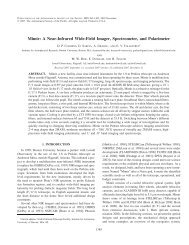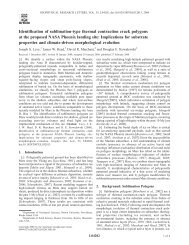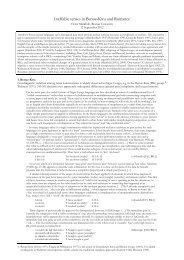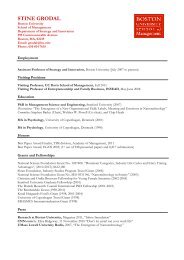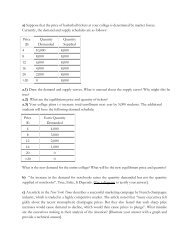D Appendix: Proofs for Section 4.4Proof of Proposition 3: If v ◦ u −1 is concave, it is straightforward to check that {≽ s t}is risk averse in the first stage. We now prove the reverse direction. Pick any l 1 , l 2 ∈ L <strong>and</strong>λ ∈ [0, 1]. By Theorem 3, we havewhereV (c, λl 1 + (1 − λ)l 2 ) = W ( c, v −1 ( λv ◦ u −1 (V ∗ (l 1 )) + (1 − λ)v ◦ u −1 (V ∗ (l 2 )) )) ,∫V ∗ (l) =C×∆(L)u(V (c ′ , a ′ ))dl(c ′ , a ′ )is a mixture linear function on L. Also we have(∫))V (c, δ[λl 1 ⊕ (1 − λ)l 2 ]) = W(c, v −1 v ◦ u −1 (λV ∗ (l 1 ) + (1 − λ)V ∗ (l 2 )) .LFrom the definition of risk aversion in the first stage, we have (c, δ[λl 1 ⊕ (1 − λ)l 2 ]) ≽ s t(c, λl 1 + (1 − λ)l 2 ). Thus,λv ◦ u −1 (V ∗ (l 1 )) + (1 − λ)v ◦ u −1 (V ∗ (l 2 )) ≤ v ◦ u −1 (λV ∗ (l 1 ) + (1 − λ)V ∗ (l 2 )).We may vary l 1 <strong>and</strong> l 2 to cover the whole domain of v ◦ u −1 . The above inequality impliesthat v ◦ u −1 is concave.Proof of Proposition 4: Suppose {≽ i s} is more risk averse than {≽ j t s} in the first stage.tBy definition they rank deterministic consumption streams in the same way <strong>and</strong> rank lotteriesin the second stage in the same way. So there exist representations such that V i = V j ,W i = W j <strong>and</strong> u i = u j .Since v i (V i (·)) <strong>and</strong> v j (V j (·)) are ordinally equivalent over C ∞ , there is a monotonetransformation Ψ such that v i = Ψ ◦ v j . The rest is to show that Ψ is concave. Let y, y ′ , y ′′ ∈C ∞ be such that (c, δ[δ[y]]) ∼ j s(c, λδ[δ[y ′ ]]+(1−λ)δ[δ[y ′′ ]]). This is possible due to continuitytof preference ordering. Thus, we have v j (V j (y)) = λv j (V j (y ′ )) + (1 − λ)v j (V j (y ′′ )). Since≽ i sis more risk averse than ≽ j t sin the first stage, we have (c, δ[δ[y]]) ≽ i t s(c, λδ[δ[y ′ ]] + (1 −tλ)δ[δ[y ′′ ]]), which implies v i (V i (y)) ≥ λv i (V i (y ′ )) + (1 − λ)v i (V i (y ′′ )).Since v i (V i (·)) = v i ((V j (·))) = Ψ(v j (V j (·))), we obtainΨ(u j (V j (y))) ≥ λΨ(u j (V j (y ′ ))) + (1 − λ)Ψ(u j (V j (y ′′ ))).One can choose y, y ′ , y ′′ so as to cover the whole range of u j ◦ V j . Thus, Ψ is concave. Theproof of the other direction of the proposition is routine.49
Proof of Proposition 5: When restricting to the subdomain C × ∆(L), we immediatelydeduce that ambiguity aversion implies risk aversion in the first stage. Now, we consider thereverse statement. Given h +1 , h ′ +1 ∈ H +1 , we define a ∈ ∆ (L) as in Definition 6. We thenhave( (c, a λδ[h+1 ] ⊕ (1 − λ) δ[h ′ +1], π ))for all π ∈ P s t, where the relation ≽ s t= ( c, λa (δ[h +1 ], π) ⊕ (1 − λ) a ( δ[h ′ +1], π )) ≽ s t(c, λa (δ[h+1 ], π) + (1 − λ) a ( δ[h ′ +1], π ))= ( c, a ( λδ[h +1 ] + (1 − λ) δ[h ′ +1], π )) ,follows from the definition of risk aversion in the firststage. By Axiom A7 (Dominance), we obtain:(c, λδ[h+1 ] ⊕ (1 − λ) δ[h ′ +1] ) (≽ s t c, λδ[h+1 ] + (1 − λ) δ[h ′ +1] ) .It follows from definition that the decision maker is ambiguity averse.Proof of Proposition 6:First, we show that comparative risk aversion in the first stageimplies comparative ambiguity aversion. To show i is more ambiguous averse than j, weneed to show:(c, δ[l]) ≽ j s t (c, δ[h +1 ]) =⇒ (c, δ[l]) ≽ i s t (c, δ[h +1]). (49)Given h +1 ∈ H +1 <strong>and</strong> µ s t ∈ ∆ (P s t), define b(h +1 , µ s t) ∈ ∆(L) asb(h +1 , µ s t)(L) = µ s t({π ∈ P s t : l(h +1 , π) ∈ L}),for every Borel set L ⊂ L, where l(h +1 , π) = ∑ s h +1 (s) π (s).For any preferences {≽ s t} satisfying Axioms B1-B7, we use Theorem 3 to compute:V (c, b(h +1 , µ s t))(∫ (∫)))= W(c, v −1 v ◦ u −1 u(V (c ′ , a ′ ))dl(c ′ , a ′ ) db(h +1 , µ s t)(l)LC×∆(L)( ( ∫ ( ∑∫) ))= W c, v −1 v ◦ u −1 π(s) u(V (c ′ , a ′ ))dh +1 (s)(c ′ , a ′ ) dµ s t(π)P s ts∈SC×∆(H +1 )= V s t(c, δ[h +1 ]).where we have used the change of variables theorem (Aliprantis <strong>and</strong> Border (1999, p. 452))to derive the second equality. This implies that (c, b(h +1 , µ s t)) ∼ s thave (c, b(h ′ +1, µ s t)) ∼ s t (c, δ[h ′ +1]). Thus, equation (49) is equivalent to(c, δ[l]) ≽ j s t (c, b(h +1 , µ)) =⇒ (c, δ[l]) ≽ i s t (c, b(h +1, µ)).50(c, δ[h +1 ]). Likewise, we
- Page 1: Intertemporal Substitution andRecur
- Page 6 and 7: As in KMM (2005, 2009a), we impose
- Page 8 and 9: 2. Review of the Atemporal ModelsIn
- Page 10 and 11: defined over it. Notice that by res
- Page 12: For any c ∈ C, we use δ[c] to de
- Page 15: The axiom below states that the pre
- Page 18: is ambiguity averse if he prefers a
- Page 22 and 23: Axiom B6 (Dynamic Consistency) For
- Page 24 and 25: 3. On the subdomain C × M, we obta
- Page 26 and 27: We can similarly define ambiguity l
- Page 28 and 29: epresentations under these two appr
- Page 30 and 31: where R t+1 is the market return fr
- Page 32 and 33: Segal (1987, 1990) and Seo (2009).
- Page 34 and 35: A Appendix: Proof of Theorems 1 and
- Page 36 and 37: Define v = ψ ◦ ū −1 ◦ u, wh
- Page 38 and 39: compute:∫˜ū (m) =∫=∫=∫= A
- Page 40 and 41: DefineH = {h = (h 0 , h 1 , h 2 ,
- Page 42 and 43: Lemma 5 We have the homeomorphic re
- Page 44 and 45: Finite-step-ahead acts and densenes
- Page 46 and 47: which is strictly increasing in the
- Page 48 and 49: where the second equality follows f
- Page 52 and 53: This relation holds true because i
- Page 54 and 55: In complete markets, the following
- Page 56 and 57: Ergin, H. I. and F. Gul (2009): “
- Page 58: Weil, P. (1989): “The Equity Prem



